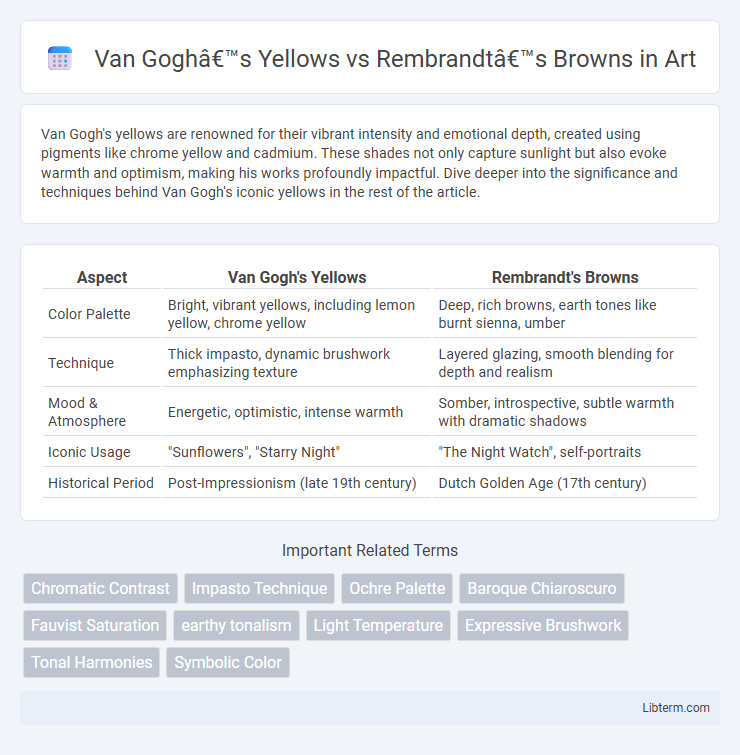Van Gogh's yellows are renowned for their vibrant intensity and emotional depth, created using pigments like chrome yellow and cadmium. These shades not only capture sunlight but also evoke warmth and optimism, making his works profoundly impactful. Dive deeper into the significance and techniques behind Van Gogh's iconic yellows in the rest of the article.
Table of Comparison
| Aspect | Van Gogh's Yellows | Rembrandt's Browns |
|---|---|---|
| Color Palette | Bright, vibrant yellows, including lemon yellow, chrome yellow | Deep, rich browns, earth tones like burnt sienna, umber |
| Technique | Thick impasto, dynamic brushwork emphasizing texture | Layered glazing, smooth blending for depth and realism |
| Mood & Atmosphere | Energetic, optimistic, intense warmth | Somber, introspective, subtle warmth with dramatic shadows |
| Iconic Usage | "Sunflowers", "Starry Night" | "The Night Watch", self-portraits |
| Historical Period | Post-Impressionism (late 19th century) | Dutch Golden Age (17th century) |
Van Gogh’s Yellows: The Symbolism of Sunlight
Van Gogh's yellows embody the vibrant energy and warmth of sunlight, symbolizing hope, vitality, and emotional intensity in his paintings. The artist frequently used bright cadmium and chrome yellows to evoke a sense of optimism and life force, contrasting with Rembrandt's more subdued, earthy browns that emphasize depth and shadow. This use of yellow highlights Van Gogh's unique approach to color symbolism, foregrounding light as a powerful emotional and spiritual presence in his work.
Rembrandt’s Browns: The Depth of Earthy Tones
Rembrandt's browns are celebrated for their rich, earthy depth achieved through layered glazes and a meticulous blending of sienna, umber, and ochre pigments. These tones create a warm, naturalistic palette that adds dimension and texture to his portraits and landscapes, enhancing the dramatic interplay of light and shadow. The nuanced browns embody the Baroque mastery of chiaroscuro, grounding compositions in a vivid yet grounded realism distinct from Van Gogh's vibrant yellows.
Color Theory: Contrasts Between Light and Shadow
Van Gogh's yellows, characterized by vibrant cadmium and lemon hues, create dynamic luminosity that contrasts sharply with deep shadows, emphasizing emotional intensity through bold light-dark juxtapositions. Rembrandt's browns, derived from earth pigments like umber and sienna, establish subtle tonal gradations that enhance three-dimensionality and evoke naturalistic depth via soft chiaroscuro effects. The color theory underpinning both artists reveals divergent approaches: Van Gogh uses complementary contrasts for expressive vibrancy, while Rembrandt employs harmonious shadows to achieve realistic volume and atmospheric mood.
The Emotional Impact of Van Gogh’s Palette
Van Gogh's vibrant yellows evoke intense emotional energy and warmth, contrasting sharply with Rembrandt's deep, earthy browns that convey solemnity and introspection. The brightness and saturation of Van Gogh's yellows amplify feelings of joy, hope, and passion, creating a dynamic, expressive atmosphere in his works. This emotional impact transforms the viewer's experience, making Van Gogh's palette a powerful tool for conveying psychological depth and emotional intensity.
Rembrandt’s Mastery of Chiaroscuro
Rembrandt's mastery of chiaroscuro is evident in his rich browns, which create dramatic contrasts between light and shadow, enhancing depth and emotional intensity. His use of warm, earthy tones and subtle gradations enables precise modeling of form and texture, showcasing his profound understanding of light's interaction with surfaces. Unlike Van Gogh's vibrant yellows that evoke energy and movement, Rembrandt's browns embody timeless realism and a somber mood through controlled tonal variation.
Pigments and Techniques: 17th vs 19th Century
Van Gogh's yellows, notably created using cadmium and chrome yellow pigments, exhibit vibrant luminosity and thick impasto techniques characteristic of 19th-century Post-Impressionism. Rembrandt's browns, typical of the 17th-century Dutch Golden Age, rely on earth pigments such as umber and sienna, applied with layered glazing methods to achieve deep tonal richness and subtle texture. The evolution from Rembrandt's meticulous layering to Van Gogh's expressive brushwork reflects advancements in pigment chemistry and artistic innovation over two centuries.
Expressive Brushstrokes: Van Gogh vs Rembrandt
Van Gogh's expressive brushstrokes in his yellows are dynamic and impassioned, often applied thickly with impasto techniques that create vibrant texture and movement. In contrast, Rembrandt's browns feature meticulous, controlled brushwork that emphasizes subtle tonal transitions and depth, enhancing the realism and mood of his subjects. The energetic application in Van Gogh's yellows contrasts with Rembrandt's refined layering, reflecting differing approaches to conveying emotion and atmosphere through pigment and technique.
Faith, Mood, and Color Choices
Van Gogh's yellows convey intense faith and emotional fervor through vibrant, luminous hues that evoke hope and spiritual transcendence. Rembrandt's browns reflect grounded faith and contemplative mood, employing rich earth tones that suggest introspection and solemnity. Their color choices underscore Van Gogh's expressive optimism contrasted with Rembrandt's restrained realism.
Influence on Modern Art: Legacy of Two Palettes
Van Gogh's vibrant yellows revolutionized modern art by introducing intense emotional energy and bold chromatic expression that influenced Fauvism and Expressionism. Rembrandt's deep, earthy browns grounded his compositions in realism and subtle tonal variations, shaping Baroque art and inspiring contemporary techniques in chiaroscuro and texture. These contrasting palettes collectively advanced the understanding of color symbolism and emotional impact in painting, leaving a lasting legacy on artistic innovation and modern visual aesthetics.
Interpreting Nature: Warmth vs Intimacy
Van Gogh's yellows evoke warmth and vitality, capturing the sun's radiant energy through vibrant, luminous tones that bring landscapes and figures to life. In contrast, Rembrandt's browns create intimacy by utilizing deep, rich earth tones that convey depth and shadow, enhancing the emotional resonance of his subjects. Both artists interpret nature distinctively, with Van Gogh emphasizing light's transformative power and Rembrandt focusing on the subtle warmth of shadowed realism.
Van Gogh’s Yellows Infographic

 libterm.com
libterm.com